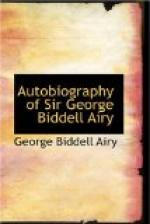There were no chairs whatever in Hall, except the single chair of the vice-master at the head of the table on the dais and that of the senior dean at the table next the East wall. All others sat on benches. And I have heard allusions to a ludicrous difficulty which occurred when some princesses (of the Royal Family) dined in the Hall, and it was a great puzzle how to get them to the right side of the benches.
The Sizars dined after all the rest; their dinner usually began soon after 4. For the non-foundationists a separate dinner was provided, as for pensioners. But for the foundationists, the remains of the Fellows’ dinner were brought down; and I think that this provision was generally preferred to the other.
The dishes at all the tables of undergraduates were of pewter, till a certain day when they were changed for porcelain. I cannot remember whether this was at the time when they became Questionists (in the October Term), or at the time when they were declared “actualiter esse in artibus Baccalaureos” (in the Lent Term).
Up to the Questionist time the undergraduate Scholars had no mixture whatever; they were the only pure table in the Hall: and I looked on this as a matter very valuable for the ultimate state of the College society. But in the October term, those who were to proceed to B.A. were drafted into the mixed body of Questionists: and they greatly disliked the change. They continued so till the Lent Term, when they were formally invited by the Bachelor Scholars to join the upper table.
Mathematical subjects of study and examination.
In the October Term 1819, the only books on Pure Mathematics were:—Euclid generally, Algebra by Dr Wood (formerly Tutor, but in 1819 Master, of St John’s College), Vince’s Fluxions and Dealtry’s Fluxions, Woodhouse’s and other Trigonometries. Not a whisper passed through the University generally on the subject of Differential Calculus; although some papers (subsequently much valued) on that subject had been written by Mr Woodhouse, fellow of Caius College; but their style was repulsive, and they never took hold of the University. Whewell’s Mechanics (1819) contains a few and easy applications of the Differential Calculus. The books on applied Mathematics were Wood’s Mechanics, Whewell’s Mechanics, Wood’s Optics, Vince’s Hydrostatics, Vince’s Astronomy, Woodhouse’s Plane Astronomy (perhaps rather later), The First Book of Newton’s Principia: I do not remember any others. These works were undoubtedly able; and for the great proportion of University students going into active life, I do not conceal my opinion that books constructed on the principles of those which I have cited were more useful than those exclusively founded on the more modern system. For those students who aimed at the mastery of results more difficult and (in the intellectual sense) more important, the older books were quite insufficient. More aspiring students read, and generally with much care, several parts of Newton’s Principia, Book I., and also Book III. (perhaps the noblest example of geometrical form of cosmical theory that the world has seen). I remember some questions from Book III. proposed in the Senate-House Examination 1823.




